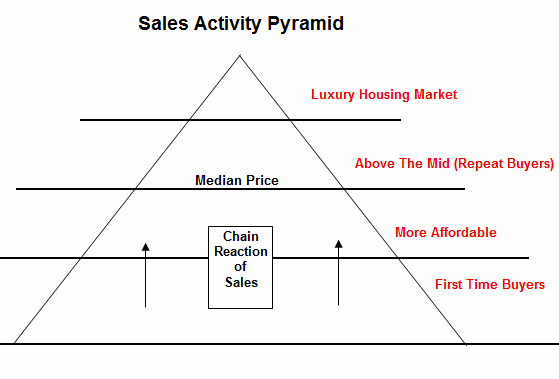Last week on the Twitter feed I linked to a post that my friend Lennox Scott put up on his blog titled First Time Buyers Are Key To Housing Market Recovery. Here’s a brief excerpt:
In my travels around the country everyone wants to know what I think it will take to get the housing market moving again. The answer is simple: first time homebuyers.
Sales Activity Pyramid – Built On First Time Buyers
If you think of the housing market in terms of a pyramid, the base is made up of “more affordable” housing which is usually represented by first time buyers; in a healthy market, this accounts for about 40% of all home sales. The middle of the pyramid represents mid-priced homes and primarily repeat buyers. The top of the pyramid represents the smallest number of buyers and the most expensive part of the housing market. As first time home buyer activity increases at the base it sets off a chain reaction of sales up the price points. It is this process that drives and sustains a healthy housing market (see chart).
So, his argument is that the best way to get the market rolling again is to recruit new buyers—investors, if you will—into this pyramid system? Intriguing…
Hey, wait a minute… This has a familiar ring to it… Where have I heard this model before? Oh yeah. Now I remember.
Pyramid schemes now come in so many forms that they may be difficult to recognize immediately. However, they all share one overriding characteristic. They promise consumers or investors large profits based primarily on recruiting others to join their program, not based on profits from any real investment or real sale of goods to the public. Some schemes may purport to sell a product, but they often simply use the product to hide their pyramid structure.
Securities & Exchange Commission:
In the classic “pyramid” scheme, participants attempt to make money solely by recruiting new participants into the program.
What Does Pyramid Scheme Mean?
An illegal investment scam based on a hierarchical setup. New recruits make up the base of the pyramid and provide the funding, or so-called returns, given to the earlier investors/recruits above them.
The main characteristic of a pyramid scheme is that participants only make money by recruiting more members.
A pyramid scheme is a non-sustainable business model that involves promising participants payment primarily for enrolling other people into the scheme, rather than from any real investment or sale of products or services to the public. Pyramid schemes are a form of fraud.
Is residential real estate inherently a pyramid scheme? No. At its most basic level, real estate is a place to live. If you buy a home you intend to live in, for a price that you feel is fair, why would you care whether or not new buyers are recruited into the market?
The problem comes when people start to view buying homes as a way to easy money (i.e. – a high-return investment). That most definitely is pyramid scheme thinking, and is exactly what caused the housing bubble to grow and continue for so long. If you’re justifying paying a high price for a home by telling yourself (or being told by a real estate “professional”) that it’s okay because more buyers will come into the market and drive up prices, you’ve fallen for a pyramid scheme.
Also, strictly speaking, Lennox’s pyramid diagram really doesn’t make any sense at all, since by definition the median price is the sale price which exactly half of all sales are above, and half below. In his pyramid, less than a quarter of the sales are shown above the median price, which is impossible.
I understand why Lennox, as a real estate salesman, would write posts and “white papers” promoting programs that get as many new people into the housing market as possible, and even why he would write nonsensical statements like “many first time buyers are in a strong position to buy but lack the necessary 3.5% down payment.” I just hope that people have learned their lesson from the bubble about the non-sustainability and consequences of real estate pyramids, and the risk of taking advice and market predictions from real estate professionals at face value.
Hat tip: EconE
